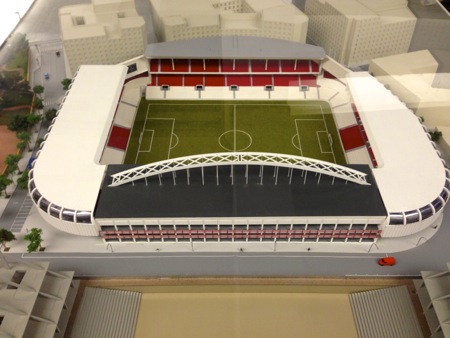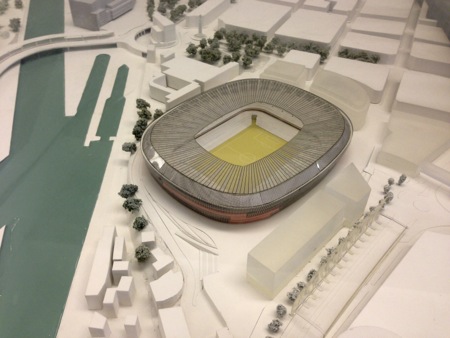
100 years of a stadium – time for a restart. On may, 26th I joined the last official match at the Cathedral, on the 29th I went a last time to the stadium to visit the museum and a guided tour through the stadium. A documentation I stored in my gallery.
Here a brief history of the last hundred years and the future:
San Mamés: From 100 to 0
By sheer chance, it has become the most amazing urban monument in 2013. And it is not so much due to its specific influence, which it undoubtedly has, and to a large scale, but rather, from the combination that stems from linking the current version, the 100-year old one, to the future one. The San Mamés football ground currently displays a very curious game of numbers and structures: the old stadium celebrates its hundredth anniversary, and the new one will inaugurate its zero year during the start of the 2013/2014 season; the centenary football field will remain intact, until in a few months’ time, part of its structure will be demolished to complete the new one, whose construction work advances at a vertiginous pace. The important thing is the fact that both together or apart, under construction, or about to be demolished, San Mamés currently comprises two stadiums that will be united into one.
Everything commenced on the 10th of December, 1912, when the Athletic Club held an Extraordinary General Meeting in order to approve the construction of a new stadium on a leased plot of land at the end of the Gran Via, next to the old people’s home of San Mamés, which was then located in the outskirts of Bilbao. It was estimated that around 50.000 pesetas (302€) would be required for constructing the football grounds, hence the Board of Directors asked a small group of dignitaries and the members in general for a loan. Funds adding up to a total of 40.770 pesetas (245.60 €) were received by general subscription, hence the construction works commenced very quickly. On the 20th of January 1913, construction works directed by the famous architect, Manuel Maria Smith, commenced. Seven months later, the new football ground (including stadium and pitch), with an English style, became a reality. It could house over seven’thousand spectators, three thousand of which could be comfortably seated in a magnificent wooden stand. But, throughout its history, San Mamés has experienced multiple structural modifications. The most significant being the arch, which has characterized the building, and dates back to 1953. The refurbishment of the main stand was an innovation at the time, because it was the first time that the typology of the arch was used for a sports structure, apart from having the largest reinforced concrete roof in Europe. Subsequently, the rest of the tribunes were added: the South in 1956, the North in 1962, and the East in 1972.
In 1982, during the World Football Championship, when Bilbao was one of the sites chosen for the matches, San Mamés experienced the last of its large remodelling works, which led to its current configuration. At the time, the stadium had a capacity to seat 46,000 people, which was reduced to the current 40,000 spectators, to comply with UEFAs safety standards. And 2013 is the year of its centenary, but also of its farewell, as demolition works will commence in June in order to complete the new grounds being built only a few metres away.

2013: THE ZERO YEAR
The first stone for the new sports ground was laid on the 26th of May, 2010, although the works officially commenced one month later. The Stadium will be fully concluded in 2014, although the Athletic Club will begin to play there during the 2013/14 football season, lacking the fourth tribune, which is the one that will be located in the area that houses the current football ground. It will have a capacity to house 53,000 seats and will have 122 VIP boxes and over 300 underground parking lots. The stadium will also be granted Category 4, which entails that European finals and world championships can be held in the same, as well as other international events.
This new stadium, which is jointly owned by the Athletic of Bilbao, the City Council of Bilbao, the Regional Government and the BBK, will be used mainly by the Athletic Club to practice football, but it will also be used for complementary activities, which include a sports innovation centre, and a sports medicine centre, an underground athletics track, and a municipal Sports centre. It will also be used as a venue for important concerts, as was the case with the former football ground.
Less than six months away from its inauguration date, the new San Mames already displays the structure over which a majestic roof will enable 53,000 spectators to enjoy the game without getting wet on the stands, as well as the first red seats. Another characteristic of the new grounds is that its facade will display three giant LED screens for publicity purposes, although the one visible from the Licenciado Poza street will display the image of the Athletic’s badge, hence the symbols of the current San Mames will be maintained. Another element that no football fan would like to miss out on is the ‘cosy little place’ effect. which is there thanks to the proximity of the public to the pitch in the current stadium, which is one of the oldest and most relevant in Europe. It seems that the new one will maintain this effect since the stands will be very vertical and will be less than seven metres from the pitch. In this context, the fans, always respectful and displaying an exemplary behaviour and fully devoted to their team, will still be able to proudly bear the nickname la Catedral’ (The Cathedral).
A text published by the Bilbao Guide No. 90, May / June 2013
